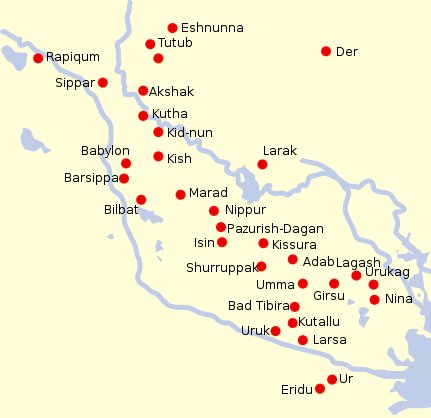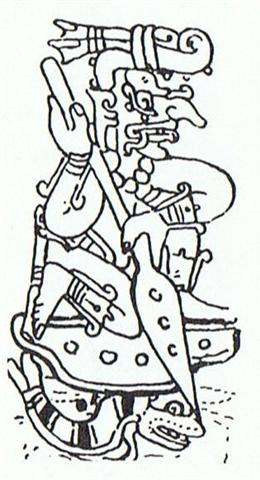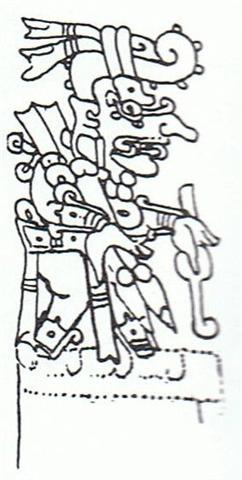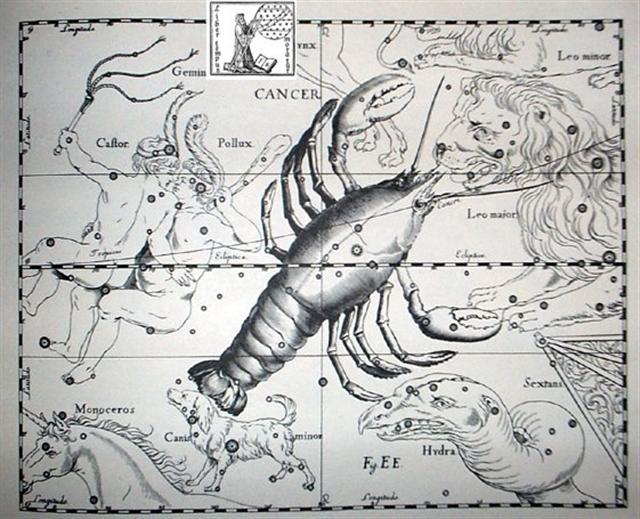199. There was a fertile Mud plain where the River reached to its end:
"Now Eridanus, the watery grave of Phaeton - Athanasius Kircher's star map of the southern hemisphere still shows Phaethon's mortal frame lying in the stream - was seen as a starry river leading up to the other world. The initial frame stands, this time traced in the sky. And here comes a crucial confirmation. That mysterious place, pī nārāti, literally the mouth of the rivers', meaning, however, the 'confluence' of the rivers, was traditionally identified by the Babylonians with Eridu. But the archeological site of Eridu is nowhere near the confluence of the Two Rivers of Mesopotamia. It is between [?] the Tigris and Euphrates, which flow separately into the Red Sea, and placed rather high up.  The proposed explanation, that it was the expanding of alluvial land which removed Eridu from the joint 'mouth' of the rivers, did not contribute much to an understanding of the mythical topos of pī nārāti, and some perplexed philologist supposed in despair that those same archaic people who had built up such impressive waterworks had never known which way the waters flow and had believed, instead, that the two rivers had their source in the Persian Gulf ..." (Hamlet's Mill, pp. 210-211) Joseph Campbell, The Masks of God: Primitive Mythology: ... and then, with stunning abruptness, at a crucial date that can be almost precisely fixed at 3200 BC (in the period of the archaeological stratum known as Uruk B), there appears in this little Sumerian mud garden - as though the flowers of its tiny cities were suddenly bursting into bloom - the whole cultural syndrome that has since constituted the germinal unit of all the high civilization of the world. And we cannot attribute this event to any achievement of the mentality of simple peasants. Nor was it the mechanical consequence of a simple piling up of material artifacts, economically determined. It was actually and clearly the highly conscious creation (this much can be asserted with complete assurance) of the mind and science of a new order of humanity, which had never before appeared in the history of mankind; namely, the professional, full-time, initiated, strictly regimented temple priest. The new inspiration of civilized life was based, first, on the discovery, through long and meticulous, carefully checked and rechecked observations, that there were, besides the sun and moon, five other visible or barely visible heavenly spheres (to wit, Mercury, Venus, Mars, Jupiter, and Saturn) which moved in established courses, according to established laws, along the ways followed by the sun and moon, among the fixed stars; and then, second, on the almost insane, playful, yet potentially terrible notion that the laws governing the movements of the seven heavenly spheres should in some mystical way be the same as those governing the life and thought of men on earth. The whole city, not simply the temple area, was now conceived as an imitation on earth of the cosmic order, a sociological 'middle cosmos', or mesocosm, established by priestcraft between the macrocosm of the universe and the microcosm of the individual, making visible the one essential form of all. The king was the center, as a human representative of the power made celestially manifest either in the sun or the moon, according to the focus of the local cult; the walled city was organized architecturally in the design of a quartered circle (like the circles designed on the ceramic ware of the period just preceeding), centered around the pivotal sanctum of the palace or ziggurat (as the ceramic designs around the cross, rosette, or swastika); and there was a mathematically structured calendar to regulate the seasons of the city's life according to the passages of the sun and moon among the stars - as well as a highly developed system of liturgical arts, including music, the art rendering audible to human ears the world-ordering harmony of the celestial spheres. It was at this moment in human destiny that the art of writing first appeared in the world and that scriptorially documented history therefore begins. Also, the wheel appeared. And we have evidence of the development of the two numerical systems still normally employed throughout the civilized world, the decimal and the sexigesimal; the former was used mostly for business accounts in the offices of the temple compounds, where the grain was stored that had been collected as taxes, and the latter for the ritualistic measuring of space and time as well. Three hundred and sixty degrees, then as now, represented the circumference of a circle - the cycle of the horizon - while three hundred and sixty days, plus five, marked the measurement of the circle of the year, the cycle of time. The five intercalated days that bring the total to three hundred and sixty-five were taken to represent a sacred opening through which spiritual energy flowed into the round of the temporal universe from the pleroma of eternity, and they were designated, consequently, days of holy feast and festival. Comparably, the ziggurat, the pivotal point in the center of the sacred circle of space, where the earthly and heavenly powers joined, was also characterized by the number five; for the four sides of the tower, oriented to the points of the compass, came together at the summit, the fifth point, and it was there that the energy of heaven met the earth. The early Sumerian temple tower with the hieratically organized little city surrounding it, where everyone played his role according to the rules of a celestially inspired divine game, supplied the model of paradise that we find, centuries later, in the Hindu-Buddhist imagery of the world mountain, Sumeru, whose jeweled slopes, facing the four directions, peopled on the west by sacred serpents, on the south by gnomes, on the north by earth giants, and on the east by divine musicians, rose from the mid-point of the earth as the vertical axis of the egg-shaped universe, and bore on its quadrangular summit the palatial mansions of the deathless gods, whose towered city was known as Amaravati, 'The Town Immortal'. But it was the model also of the Greek Olympus, the Aztec temples of the sun, and Dante's holy mountain of Purgatory, bearing on its summit the Earthly Paradise. For the form and concept of the City of God conceived as a 'mesochosm' (an earthly imitation of the celestial order of the macrocosm) which emerged on the threshold of history circa 3200 BC, at precisely that geographical point where the rivers of Tigris and Euphrates reach the Persian Gulf, was disseminated eastward and westward along the ways already blazed by the earlier neolithic. The wonderful life-organizing assemblage of ideas and principles - including those of kingship, writing, mathematics, and calendrical astronomy - reached the Nile, circa 2800 BC; it spread to Crete on the one hand, and on the other, to the valley of the Indus, circa 2600 BC; to Shang China, circa 1600 BC; and, according to at least one high authority, Dr Robert Heine-Geldern, from China across the Pacific, during the prosperous seafaring period of the late Chou Dynasty, between the seventh and fourth centuries BC, to Peru and Middle America ... In the C text there is a silent bird after heliacal Altair, but then there was a Sun who stood up at glyph 100 - a place to be counted from (hia):
... Lobster said to Flounder: 'Let us-two hide from each other, see who is best at that.' Flounder agreed to play this game. Lobster went to a hole in the coral, hid his body; but his feelers stuck out, he could not hide them. Flounder knew where he was, found him. Said Flounder; 'Now it is my turn.' He stirred up a cloud of mud and scooted into it. Then he returned to Lobster's side, so quietly that Lobster did not know he was there. 'Here I am sir, Lobster!' Lobster was so angry at being beaten that he stamped on the fish and smashed him flat. Cried Flounder; 'Now I've got one eye in the mud!' Therefore Lobster gouged it out for him and roughly stuck it back on top. This is the reason why men tread on the Flounder, but can always see the Lobster's feelers outside his hole ...
|
|||||||||||||||||||||||||||||||||||||||||||||||||||||||||||||||||||||||||||||||||||||||||||||||||||||||||||||||||||||||||||||||||||||||||||||||||||||
















